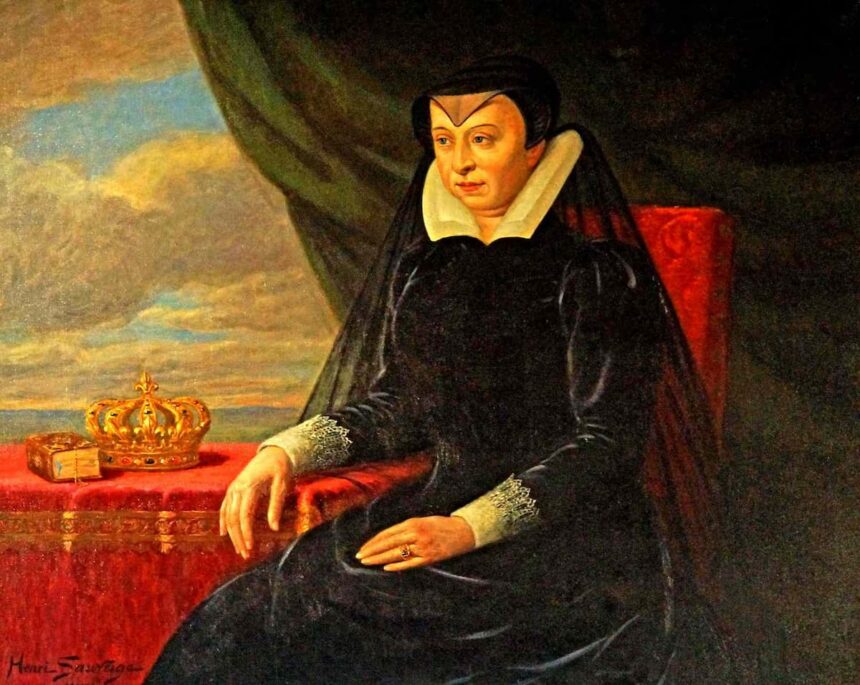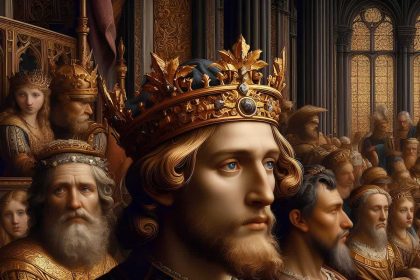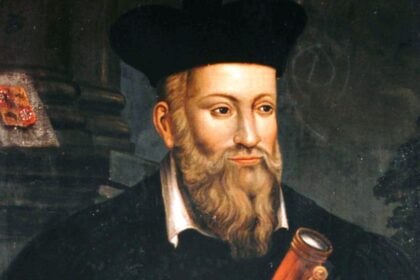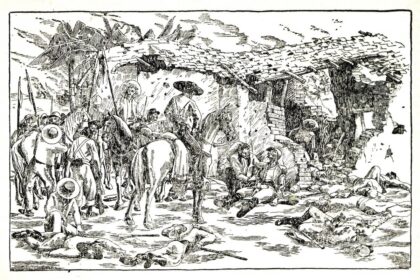Catherine de’ Medici was born on April 13, 1519, in Florence, Italy. Wife of Henry II and Queen of France from 1547 to 1559, she was also the mother of three kings of France: Francis II, Charles IX, and Henry III; as well as, among others, Elizabeth of France (1546–1568), who became Queen of Spain by marrying Philip II, Marguerite (known as “Queen Margot,” wife of the future Henry IV), and Claude of France (1547–1575), Duchess of Lorraine. After the death of her son Francis II in 1560, she assumed the regency of the kingdom for her second son, Charles IX, who was then 10 years old. From that point on, she played a predominant role in French political affairs, serving as regent of the kingdom of France until 1574.
Starting in 1562, when the Wars of Religion broke out between Catholics and Protestants, she constantly sought to find agreements between the belligerents to bring peace to France. Catherine de’ Medici was thus behind the signing of many peace treaties but was also, paradoxically, the instigator of the St. Bartholomew’s Day Massacre. She died on January 5, 1589, in Blois, France, without having been able to end the French Wars of Religion, which bloodied France from 1562 to 1598.
Genealogy of Catherine de’ Medici
Daughter of Lorenzo II de’ Medici (1492–1519), Duke of Urbino, and Madeleine de la Tour d’Auvergne (1495–1519), Catherine de’ Medici grew up in Italy, her father’s homeland. At the death of her parents, she became Duchess of Urbino, and later Countess of Auvergne after the death of her aunt, Anne of Auvergne, in 1524. She married the future Henry II in 1533 and through this union, became Dauphine and Duchess of Brittany from 1536 to 1547, before her husband’s accession to the throne made her Queen of France from 1547 to 1559.
With Henry II, she had ten children:
- Francis II (1544–1560)
- Elizabeth (1545–1568), married to King Philip II of Spain
- Claude (1547–1575), married to Duke Charles III of Lorraine
- Louis (1549)
- Charles IX (1550–1574)
- Henry III (1551–1589)
- Margaret (1553–1615), married to King Henry III of Navarre (the future Henry IV of France)
- Francis, Duke of Anjou (1554–1584); his death without issue made the Protestant Henry of Navarre the heir to the French throne
- Jeanne and Victoire, twins (1556)
Husband of Catherine de’ Medici
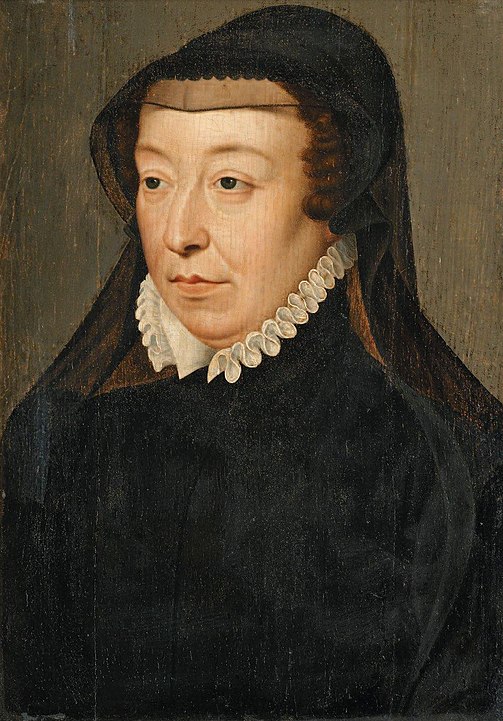
The marriage between Catherine de’ Medici and Henry II of France (Duke Henry of Orléans) took place in 1533. He was the second son of King Francis I of France and was not expected to reign. However, after the death of his older brother, the Dauphin Francis, in 1536, Henry, Duke of Orléans, became King Henry II in 1547. During her husband’s reign, Catherine de’ Medici had to step aside for Diane de Poitiers, the king’s mistress. King Henry II died in 1559.
Regency of Catherine de’ Medici
Born on April 13, 1519, in Florence as Caterina Maria Romola di Lorenzo de’ Medici, Catherine de’ Medici lost both her parents at a very young age. She spent her early years in Rome and later married Duke Henry of Orléans. This marked her first steps at the French court. However, the young Italian was quickly overshadowed by her husband’s mistress, Diane de Poitiers. Once in the background, Catherine de’ Medici increasingly took on political roles after the deaths of her husband, Henry II, and her son, Francis II. When her other son, Charles IX, ascended the throne, she became regent of the country and quickly had to deal with religious dissensions.
Advocating conciliation and supported by Minister Michel de l’Hospital, she initially favored tolerance and sought to establish peace between Protestants and Catholics (Edict of Amboise, 1563, and Peace of Saint-Germain, 1570). A devout Catholic, Catherine de’ Medici still supported the marriage of her daughter, Marguerite of Valois, to the Protestant Henry of Navarre, the future Henry IV, in 1572. However, she remained distrustful of the Huguenots and Admiral Coligny, which contributed to her involvement in the St. Bartholomew’s Day Massacre in 1572.
Catherine de’ Medici and Nostradamus
Catherine de’ Medici brought Nostradamus to court and appointed him as the king’s physician and advisor in 1564. In the 16th century, astrologers were regarded as highly respected scholars. Since her marriage to Henry, the second son of Francis I, at the age of 14, Catherine de’ Medici had consulted astrologers. Highly superstitious, she also regularly summoned Cosimo Ruggieri, a Florentine astrologer, to France. The famous Nostradamus is said to have predicted for Catherine, among other things, the circumstances of her husband’s death and that her three sons would succeed each other on the French throne before being replaced by Henry of Navarre.
Charles IX: Son of Catherine de’ Medici
Born on June 27, 1550, and died on May 30, 1574, Charles IX was the fifth of Catherine de’ Medici’s ten children. After the death of his brother Louis, who died on October 24, 1550, at the age of 1 year and 8 months, Charles became Duke of Orléans. He ascended to the throne after the death of his older brother Francis II in 1560. In 1570, he married Elizabeth of Austria, with whom he had one daughter. He reigned until his death in 1574 at the age of 24.
Death of Catherine de’ Medici
Still regent at the ascension of her third son, Henry III, in 1574, Catherine de’ Medici’s influence began to wane. She died on January 5, 1589, at the age of 70, a few months before the death of her last son, Henry III. He ultimately ceded the throne to the Bourbons and Henry IV, his brother-in-law. A patron of the arts, Catherine de’ Medici contributed to the construction of parts of the Louvre and the Tuileries Palace.
Catherine de’ Medici: Key Dates
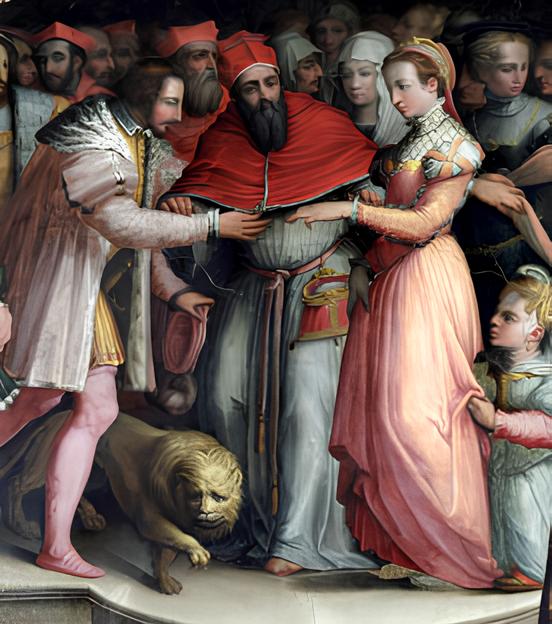
- April 13, 1519: Birth of Catherine de’ Medici in Florence, Italy.
- October 28, 1533: Marriage of the Henry II of France (Duke of Orléans) and Catherine de Medici
Pope Clement VII officiates the marriage of Henry of Orléans and his niece, Catherine de Medici, in Marseille. When the Duke of Orléans becomes Henry II in 1547, Catherine de Medici will become the Queen of France. Together, they will have ten children. - January 19, 1544: Birth of Francis II
After 11 years of marriage to Dauphin Henry II (son of Francis I), Catherine de Medici gives birth to a son, Francis, the future Francis II. Married to Mary Stuart of Scotland, he will become King of France at 15 in 1559. However, his reign, dominated by the Guise family, will last only a year and a half. Francis II dies on December 5, 1560, from an ear infection. - June 27, 1550: Birth of Charles IX
Charles IX will succeed his elder brother Francis II at the age of 10. - September 19, 1551: Birth of Henry III
The third son of Henry II and Catherine de Medici is baptized Alexander-Edward at birth. He will take the name Henry upon confirmation. His mother will have him elected King of Poland in 1573 at the age of 22. However, he will not have time to exercise this role as he is abruptly called to succeed his brother Charles IX on the French throne. Henry III will often be criticized for his complex personality and fondness for his favorites, the “mignons.” - December 5, 1560: Charles IX succeeds Francis II
After the death of Francis II from an ear infection, his brother Charles IX, aged 10, succeeds him but cannot govern alone. Queen mother Catherine de Medici takes over as regent and will rule behind the scenes until her son’s death in 1574. - September 9, 1561: Start of the Colloquy of Poissy, which attempts to reconcile Catholics and Protestants
The Colloquy of Poissy takes place from September 9 to October 14, 1561. Convened at the initiative of Catherine de Medici, it aims to achieve reconciliation between Catholics and Protestants. However, the inability to agree on the presence or absence of Christ during the Eucharist leads to a breakdown. Catherine de Medici abandons hopes for religious unity. - January 17, 1562: Signing of the January Edict
Pressured by his mother, Catherine de Medici, and Chancellor Michel de l’Hôpital, King Charles IX signs the January Edict in Saint-Germain-en-Laye. It grants Protestants freedom of worship outside city walls, in exchange for their relinquishment of churches they had seized. However, this edict only intensifies Catholic anger, especially from the Duke of Guise, who will soon organize the Massacre of Wassy, sparking the first War of Religion. - September 28, 1567: Attempted abduction of Charles IX
Fearing the consequences of Catherine de Medici’ negotiations with Catholic Spain, Prince of Condé organizes the abduction of King Charles IX. The plot fails, leading to the second War of Religion. In November, the Protestants suffer a devastating defeat by the Duke of Montmorency at Saint-Denis, leading them to sign the Peace of Longjumeau. - March 23, 1568: Peace of Longjumeau
Signed between Charles IX and Prince of Condé, this peace ends the second War of Religion. The conflict between Protestants and Catholics had resumed in September 1567. Both sides, financially ruined, are forced to negotiate again. The treaty reaffirms the rights granted to Protestants by the Peace of Amboise, signed on March 19, 1563. However, the truce will be short-lived as the third War of Religion begins five months later. - March 13, 1569: Protestants defeated at Jarnac
The third War of Religion erupts following King Charles IX’s decision, influenced by Catherine de Medici, to order the arrest of Prince of Condé. Forced to take up arms again, the Protestants face the Catholics once more. The Battle of Jarnac ends with a Protestant defeat and the death of Condé. - August 18, 1572: Marriage of Henry of Navarre and Queen Margot
To attempt reconciliation between Protestants and Catholics, Jeanne d’Albret and Catherine de Medici arrange the marriage of their children, Henry of Navarre and Marguerite de Valois. The Catholics take advantage of the gathering of Protestants for the wedding in Paris to order the St. Bartholomew’s Day Massacre (night of August 23-24, 1572). Henry of Navarre, who becomes King of France as Henry IV in 1589, will have the marriage annulled in 1599 and marry Marie de Medici in 1600. - August 22, 1572: Coligny escapes assassination
Gaspard de Coligny, increasingly influential with King Charles IX, arouses suspicion in Catherine de Medici and revives Catholic hatred. The Protestant leader tries to convince the king to intervene in the Netherlands against Spain. This likely motivates the Guise family, staunch defenders of Catholicism, to attempt his assassination.buy kamagra oral jelly online http://psychrecoveryinc.com/images/newSpace/jpg/kamagra-oral-jelly.html no prescription pharmacy
Though Coligny escapes, the event triggers the St. Bartholomew’s Day Massacre two days later.buy addyi online https://buynoprescriptiononlinerxx.net/buy-addyi.html no prescription pharmacy
Coligny is one of the first Protestants to be killed. - August 24, 1572: St. Bartholomew’s Day Massacre
On the night of August 23-24, 1572, Protestants gathered in Paris for the wedding of their leader Henry of Navarre to Marguerite de Valois are massacred. Two days earlier, the assassination attempt on Coligny, likely orchestrated by the Guise family, had created dangerous tensions. Fearing a coup by the Guise family, Catherine de Medici, wary of Coligny’s influence over her son Charles IX, convinced him to order the massacre of Protestant leaders. When the bells of Saint-Germain-l’Auxerrois ring, Parisians unleash violence on Protestants, men, women, and children.buy doxycycline online https://buynoprescriptiononlinerxx.net/buy-doxycycline.html no prescription pharmacy
The massacre claims 3,000 victims and continues in the provinces until October. Henry of Navarre is forced to convert.buy synthroid online https://buynoprescriptiononlinerxx.net/buy-synthroid.html no prescription pharmacy
This is one of the bloodiest episodes of the Wars of Religion that ravaged the kingdom from 1562 to 1598. - February 13, 1575: Coronation of Henry III
The fourth son of Henry II and Catherine de Medici is crowned King of France in Reims. Henry III is in Kraków, on the Polish throne, when he learns of the death of his brother King Charles IX (May 30, 1574). His return journey to France takes five months, during which his mother serves as regent. Two days after his coronation, Henry III marries Louise of Lorraine-Vaudémont. - January 5, 1589: Death of Catherine de Medici
Queen mother Catherine de Medici dies at the age of 70 at the Château de Blois.


